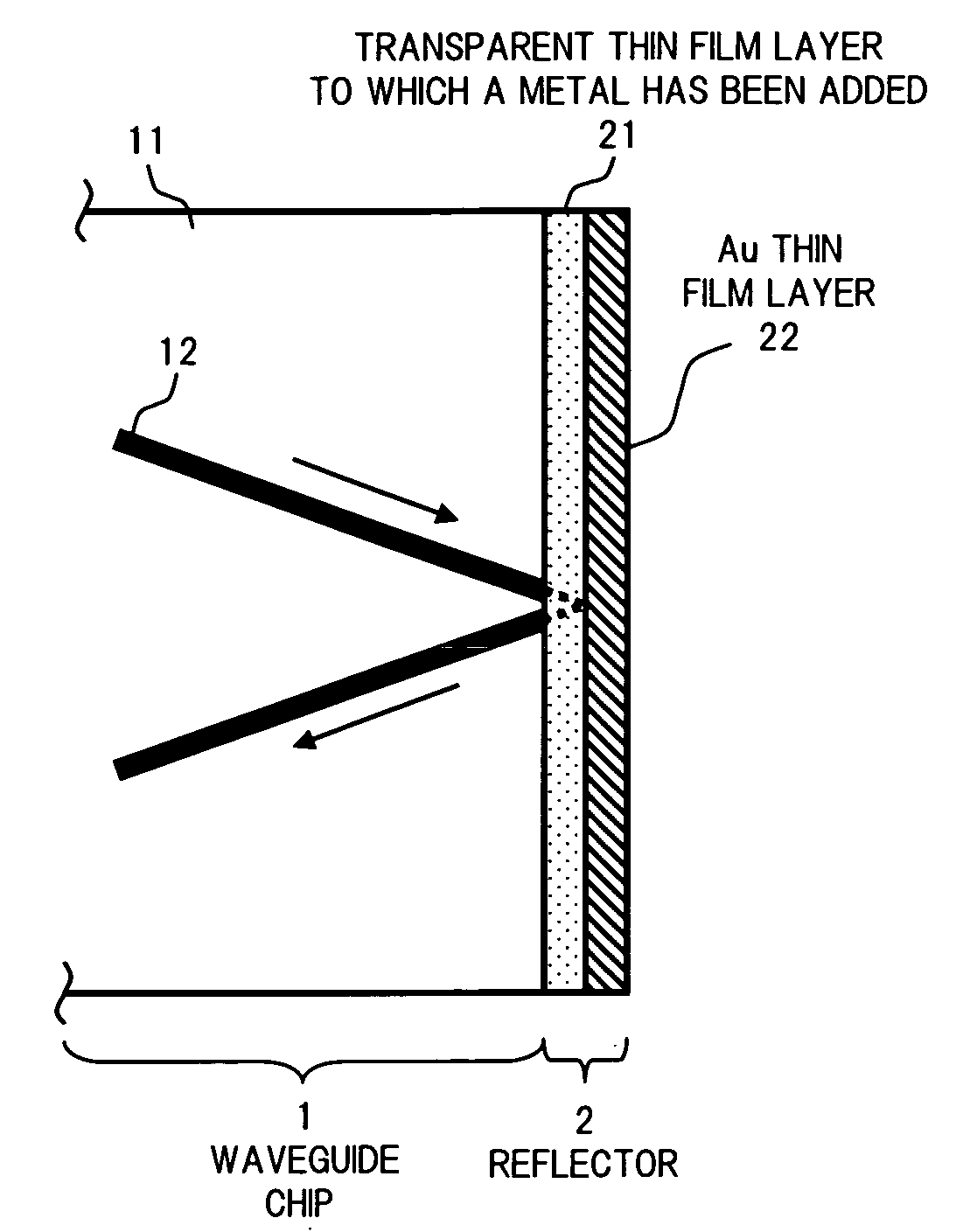Optical communication device provided with a reflector and method for forming a reflector in an optical communication device
- Summary
- Abstract
- Description
- Claims
- Application Information
AI Technical Summary
Benefits of technology
Problems solved by technology
Method used
Image
Examples
first embodiment
[0024]FIG. 1 is a plan view showing a construction of a principal part of an optical communication device according to the invention.
[0025] Referring to FIG. 1, the present optical communication device is provided, for example, with a waveguide chip 1 serving as an optical medium and a reflector 2 formed on one end surface of the waveguide chip 1.
[0026] The waveguide chip 1 has a waveguide 12 formed on an optical substrate 11. The scale reduction in the chip size is achieved by turning the waveguide 12 at the end surface of the optical substrate 11 in the same manner as in the above-described case shown in FIG. 6. As a material for the optical substrate 11, one can use, for example, lithium niobate (LiNbO3), silicon oxide (SiO2) used in a planar light-wave circuit (PLC), or a gallium arsenic (GaAs) based or indium phosphorus (InP) based optical semiconductor device, or the like.
[0027] The reflector 2 is made of a transparent thin film layer 21 and a gold (Au) thin film layer 22. W...
second embodiment
[0030] Next, the invention will be described.
[0031] In an optical communication device according to the second embodiment, a reflector 2 made of a transparent thin film layer 21 and an Au thin film layer 22 is formed on an end surface of a waveguide chip 1, in the same manner as in the construction of the above-described first embodiment shown in FIG. 1. The difference from the construction of the first embodiment lies in that the metal added to SiO2 as a material of the transparent thin film layer 21 is a metal that forms a complete solid solution with Au.
[0032] The metal that forms a complete solid solution with Au may be, for example, silver (Ag), platinum (Pt), or the like. At least one among these metals is added to SiO2. The kind and the concentration of the metal added to SiO2 are set by considering the effect for improvement of the adhesion strength of the Au thin film layer 22 and the transmittance of the transparent thin film layer 21, in the same manner as in the first e...
third embodiment
[0034] Next, the invention will be described.
[0035] In an optical communication device according to the third embodiment, a reflector 2 made of a transparent thin film layer 21 and an Au thin film layer 22 is formed on an end surface of a waveguide chip 1, in the same manner as in the construction of the above-described first embodiment shown in FIG. 1. The difference from the construction of the first embodiment lies in that the metal added to SiO2 as a material of the transparent thin film layer 21 is a metal having an oxide formation free energy of −6.3×105 joule (=−150 kcal) or below.
[0036] The oxide formation free energy represents the reactivity of a metal to oxygen. A metal having a smaller value thereof, i.e. a metal that is more liable to be oxidized, has a stronger interfacial bond. Considering the interfacial bond with the Au thin film layer 22, when a metal having an oxide formation free energy of −6.3×105 joule or below is contained in the transparent thin film layer 2...
PUM
 Login to View More
Login to View More Abstract
Description
Claims
Application Information
 Login to View More
Login to View More - R&D
- Intellectual Property
- Life Sciences
- Materials
- Tech Scout
- Unparalleled Data Quality
- Higher Quality Content
- 60% Fewer Hallucinations
Browse by: Latest US Patents, China's latest patents, Technical Efficacy Thesaurus, Application Domain, Technology Topic, Popular Technical Reports.
© 2025 PatSnap. All rights reserved.Legal|Privacy policy|Modern Slavery Act Transparency Statement|Sitemap|About US| Contact US: help@patsnap.com



